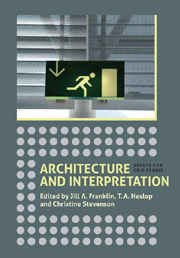Book contents
- Frontmatter
- Contents
- List of Illustrations
- Preface: In Appreciation
- List of contributors
- 1 Introduction
- Incitements to Interpret in Late Antique and Medieval Architecture
- Authors and Intentions
- 146 Home Sweet Mammoth: Neuroarchaeology and the Origins of Architecture
- 163 Constantine and Helena: The Roman in English Romanesque
- 176 For Their Monuments, Look about You: Medieval Masons and their Tombs
- 192 Baxandall's Bridge and Charles IV's Prague: An Exercise in Architectural Intention
- 221 Imitation as a Creative Vehicle in Michelangelo's Art and Architecture
- 242 The ‘Façade Problem’ in Roman Churches, c. 1540–1640
- Architecture beyond Building
- Index
221 - Imitation as a Creative Vehicle in Michelangelo's Art and Architecture
from Authors and Intentions
Published online by Cambridge University Press: 05 April 2013
- Frontmatter
- Contents
- List of Illustrations
- Preface: In Appreciation
- List of contributors
- 1 Introduction
- Incitements to Interpret in Late Antique and Medieval Architecture
- Authors and Intentions
- 146 Home Sweet Mammoth: Neuroarchaeology and the Origins of Architecture
- 163 Constantine and Helena: The Roman in English Romanesque
- 176 For Their Monuments, Look about You: Medieval Masons and their Tombs
- 192 Baxandall's Bridge and Charles IV's Prague: An Exercise in Architectural Intention
- 221 Imitation as a Creative Vehicle in Michelangelo's Art and Architecture
- 242 The ‘Façade Problem’ in Roman Churches, c. 1540–1640
- Architecture beyond Building
- Index
Summary
EXPLAINING BUILDINGS, as Eric Fernie impressed on me as a student, is a prime duty of an architectural historian. Doing so with reference to an architect's particular design philosophy and creative process can, additionally, help account for the differences between their buildings and those of other architects, especially if this approach can be supported by informed contemporary testimony. Explaining Michelangelo's buildings in this way presents a sizable challenge, but, as I have argued in a case study elsewhere, they would appear to owe much of their remarkable character to his attitude towards imitation, an attitude that was fundamentally different from those of other architects of the period. Unlike architects who based their designs closely and recognizably on particular ancient – or modern – prototypes of agreed merit, Michelangelo instead viewed his as the products of a transformative process that involved the assimilation of many different models. This approach, as manifested in his designs for the New Sacristy (begun 1519; fig. 1) and especially the Laurentian Library (begun 1524) in Florence, was to an extent recognized by Michelangelo's devoted biographer, Giorgio Vasari, when he declared (1550) that Michelangelo had conceived their designs in a way ‘quite different’ from those who worked ‘following common usage and following Vitruvius and the works of antiquity’, and famously remarked that he had broken the ‘ties and chains’ that had previously kept architects on a ‘common road’. Yet although Michelangelo's approach was a radical departure from the practices of his contemporaries, it was not entirely without precedent, since it was in some respects anticipated by that of his Florentine predecessor, Giuliano da Sangallo.
- Type
- Chapter
- Information
- Architecture and InterpretationEssays for Eric Fernie, pp. 221 - 241Publisher: Boydell & BrewerPrint publication year: 2012



